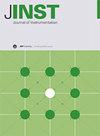Design, fabrication and validation of an electrical conductivity principle based two-phase detection sensor array for molten lead (Pb) based heavy metal coolants up to 600^∘C
IF 1.3
4区 工程技术
Q3 INSTRUMENTS & INSTRUMENTATION
引用次数: 0
Abstract
Molten lead (Pb) and its alloys (PbBi and PbLi) are of immense interest for various nuclear engineering applications, including but not limited to advanced Lead-cooled Fast Reactors (LFRs), tritium Breeding Blankets (BBs) of fusion power plants and spallation targets for Accelerator-Driven Systems (ADS). Owing to their attractive thermophysical properties, these advanced fluids assert their candidacy to address the critical requirements of neutron multiplication, neutron moderation, high temperature coolants and tritium breeders, enabling the operation of next generation nuclear systems at high temperatures with better efficiencies. However, for numerous reasons such as a compromise of structural integrity at the heat transfer interface, presence of an inert cover gas during charging of molten metal in the loop, and the fusion fuel cycle itself may lead to molten metal-gas two-phase flows with high density ratios. At present, no effective diagnostics exist to detect such operational and accidental occurrences in high temperature molten metal systems resulting in a severe lack of relevant experimental studies. To address these limitations and to advance the current understanding toward two-phase regimes in high temperature Pb-based melts, the present work focuses on the design and assembly aspects of an electrical conductivity-based two-phase detection sensor array, utilizing high purity α-Al2O4 coatings with AlPO4 binder as electrical insulation layers. This paper discusses the design considerations, thermal analysis, systematic selection of structural/functional components along with preliminary results from the probe performance tests in very high temperature (600°C) static molten Pb column for real time detection of argon gas bubbles rising within the melt. Quantitative estimations of time-averaged void fraction, average bubble impaction frequency and average bubble residence time are presented from the preliminary experimental investigations.设计、制造和验证基于电导率原理的两相检测传感器阵列,用于温度高达 600^∘C 的熔融铅 (Pb) 重金属冷却剂
熔融铅(Pb)及其合金(PbBi 和 PbLi)在各种核工程应用中具有极大的兴趣,包括但不限于先进的铅冷快堆 (LFR)、核聚变发电厂的氚增殖毯 (BB) 以及加速器驱动系统 (ADS) 的溅射靶。由于这些先进流体具有极具吸引力的热物理性质,因此可以满足中子倍增、中子慢化、高温冷却剂和氚增殖体的关键要求,使下一代核系统能够在高温下以更高的效率运行。然而,由于多种原因,如传热界面的结构完整性受到影响、回路中熔融金属装料时存在惰性覆盖气体以及聚变燃料循环本身可能导致高密度比的熔融金属-气体两相流。目前,还没有有效的诊断方法来检测高温熔融金属系统中发生的此类操作和事故,导致相关实验研究严重不足。为了解决这些局限性,并推进当前对高温铅基熔体中两相机制的理解,本研究重点关注基于电导率的两相检测传感器阵列的设计和组装方面,利用高纯度 αAl2O4 涂层和 AlPO4 粘合剂作为电绝缘层。本文讨论了设计考虑因素、热分析、结构/功能组件的系统选择,以及在极高温(600°C)静态熔融铅柱中进行探头性能测试的初步结果,以实时检测熔体中上升的氩气泡。通过初步实验研究,对时间平均空隙率、平均气泡撞击频率和平均气泡停留时间进行了定量估算。
本文章由计算机程序翻译,如有差异,请以英文原文为准。
求助全文
约1分钟内获得全文
求助全文
来源期刊

Journal of Instrumentation
工程技术-仪器仪表
CiteScore
2.40
自引率
15.40%
发文量
827
审稿时长
7.5 months
期刊介绍:
Journal of Instrumentation (JINST) covers major areas related to concepts and instrumentation in detector physics, accelerator science and associated experimental methods and techniques, theory, modelling and simulations. The main subject areas include.
-Accelerators: concepts, modelling, simulations and sources-
Instrumentation and hardware for accelerators: particles, synchrotron radiation, neutrons-
Detector physics: concepts, processes, methods, modelling and simulations-
Detectors, apparatus and methods for particle, astroparticle, nuclear, atomic, and molecular physics-
Instrumentation and methods for plasma research-
Methods and apparatus for astronomy and astrophysics-
Detectors, methods and apparatus for biomedical applications, life sciences and material research-
Instrumentation and techniques for medical imaging, diagnostics and therapy-
Instrumentation and techniques for dosimetry, monitoring and radiation damage-
Detectors, instrumentation and methods for non-destructive tests (NDT)-
Detector readout concepts, electronics and data acquisition methods-
Algorithms, software and data reduction methods-
Materials and associated technologies, etc.-
Engineering and technical issues.
JINST also includes a section dedicated to technical reports and instrumentation theses.
 求助内容:
求助内容: 应助结果提醒方式:
应助结果提醒方式:


